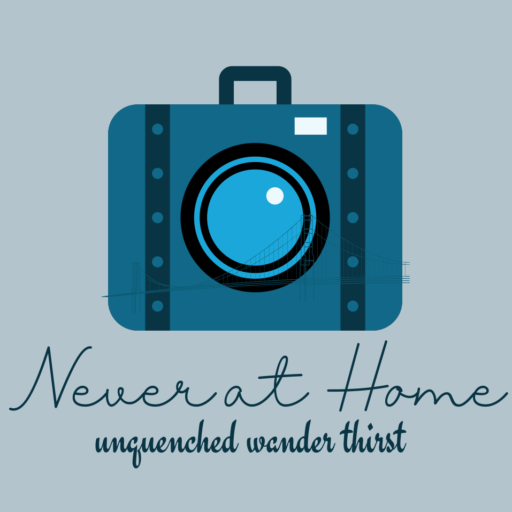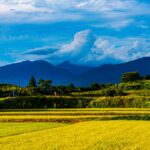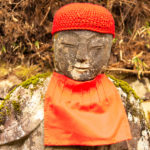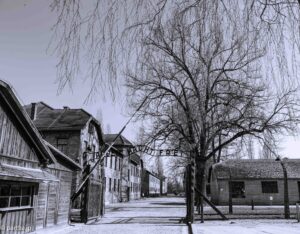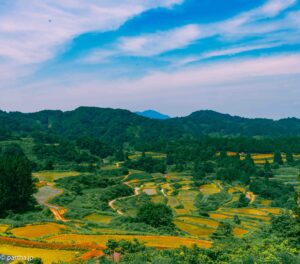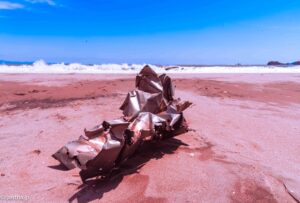
I discovered the Auschwitz Peace Museum in Japan by accident. I was planning a visit to the site of the Auschwitz concentration camp in Poland and typed the world Auschwitz when Google Maps showed a location in Fukushima prefecture.
I was momentarily surprised and stopped my search for the best means of transportation between Berlin and Auschwitz to look up this location that I had never heard of.
There was a website mentioned in the description and clicking on the link opened up a simple and basic site with limited information, but my curiousity was piqued. I did more research over the next few days, planning a trip to Poland was the priority but I made a mental note to plan a visit.
Shirakawa in Fukushima prefecture is located around 210 kilometres from Tokyo, a 150 minute drive in ideal conditions. I’ve had a mixed luck driving to Fukushima, my first trip to Urabandai took around 8 hours, the traffic held up due to a crash on the highway. The next one to Koriyama was better, taking a little under 4 hours.
The information on the website and research showed that the museum was a collection of exhibits bought over from Auschwitz and displayed in a small structure which was apparently donated by a local brewery.
The museum was the brainchild of Shinshin Aoki, a graphics designer from Japan who visited Auscwitz in 1984. He started the museum in Shioya, Tochigi prefecture in 2000. The land housing the museum was sold off and Aoki, diagnosed with terminal cancer at the time, began a search for a new location to house the museum.
A brewery in Shirakawa offered a 17,800 square metres plot to the Non-Profit that ran the museum at a reduced rent and the museum shifted to Shirakawa in 2002. Details are scarce on why the brewery offered the location, the relationship between the brewery and Aoki, who passed away later in the same year.
The museum shifted to Shirakawa and is located in a wooden house on the plot of land that was gifted by the brewery. It’s an old structure precariously wooden but standing solidly over the decades.
I planned to visit the museum on my way to Miyagi Prefecture. The Golden Week holidays in 2025 split across 2 weeks allowed me to plan the trip and avoid the inevitable crowded highways that accompany the holidays.
I set out on a Friday morning, encountering sparse early work day morning traffic before joining the Tohoku Expressway. The traffic lightened on the highway until it was almost negligible as I exited at the Shirakawa Interchange.
A few kilometres in the Prefectural Road 184, I saw a sign for the museum.
Turning towards the sign, I came across another one pointing to a narrow path, barely wide enough to fit a car, for a large one like mine it was a struggle. The path narrowed even further, a sharp turn and a few metres of nimble driving I saw a sign pointing to the parking area.
There is a signboard giving a map of the area without which you can easily miss the entrance to the museum. There was a Harley Davidson in the parking area with Shinagawa(an district in the Tokyo Metropolitan region) number plates and the biker stood there apparently lost in thoughts. It could also have been a reaction at seeing two Indians(my wife and I) getting down from the car with Tokyo Number plates.
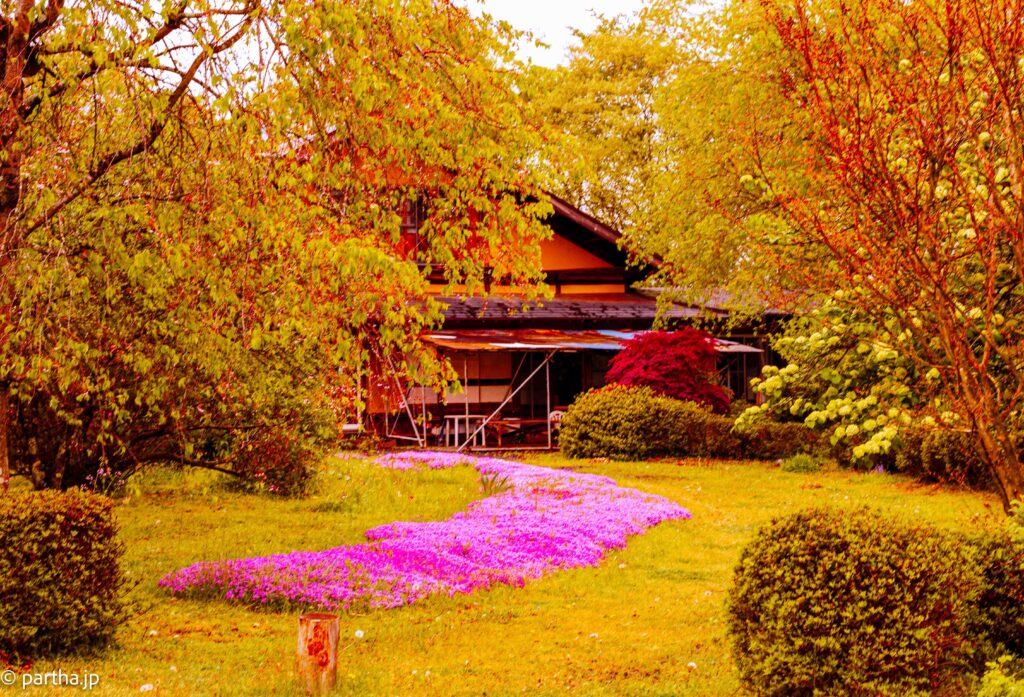
I walked into an ageing wooden house and lady, possibly in her 70s, greeted us. Tickets to the museum cost 500 Yen per head and we paid and received pamphlets. She explained the layout of the structure including the Anne Frank display located in a separate building and the train carriages that were visible from the outside.
‘Do you want to watch the video about the holocaust’, she asked ‘its 20 minutes long’.
We agreed to watch the video and she switched on the projector to start the video. I have visited Auschwitz, read about it in details over the last few months, so the information was not new, but there is a poignant end to the video which made me glad that I stayed and watched till the end.
The last frames are of two children, around 5 years old, showing their number tattoos to the cameraman, the children speak but the audio is not captured. They are possibly speaking of the pain that the tattoo burn would have caused as they point to the exact spot on their forearms and the video cuts out.
I found Auschwitz a difficult experience and watching the end of the video bought back some of the memories. The rest of the museum contains exhibits from Poland, pots and pans, shoes, clothes and even Nazi insignia. There is an urn containing the soil from Auschwitz-Birkenau, a mixture of soil, bones and ashes of the victims.
There is a gallery of people who stood up to Nazis, the section is titled ‘Rescuers’ and a description of their actions in their resistance.
The display section takes around 15-20 minutes to cover , the NPO which manages the museum have mentioned that they have around 1,000 exhibits out of which only around 100 can be displayed because of a lack of space. The NPO and the Jewish council of Kansai(region around Osaka) have plans to raise funds to construct a much bigger display space, however they are still at 20% of their collection target.
The remote location of the museum could be a contributing factor, I would not have planned a trip to Shirakawa for any other reason, also I discovered its existence by accident. However there could be other contributing factors, a general apathy, lack of knowledge and even a desire to forget the excesses of the Second World War.
There is a display on Palestine in the museum with stickers and flags bearing ‘Free Palestine’ slogan. There are also collection boxes asking for funds to support the Free Palestine movement, the destination of the funds is not very clear.
I found this puzzling, museum dedicated to Auschwitz collecting funds for organisations fighting the Israeli government. The website to the museum also mentions a documentary viewing later in May titled ’Gaza after October 7th’. The documentary is supposed to be about the ‘Genocide in Gaza’ that is not covered in the Japanese media.
I had a few questions in my mind but thought it was inappropriate to ask them and I wondered whether the lady at the reception would be able to answer and whether she would take offence at my questions.
So I kept my questions to myself and found my way to the next exhibit, the Anne Frank display. There were occasional light showers through my drive and they increased in frequency and volume during the time I was in the Auschwitz museum.
The Anne Frank display is housed in another small wood and brick house, almost a cabin and much smaller than the Auschwitz display. I struggled to find the entrance, finally found the small door and stepped into a dark room. The light switch was on my right and I pressed the two switches that were visible until the lights came on. There was a sign below the switch, which ironically was not visible in the dark.
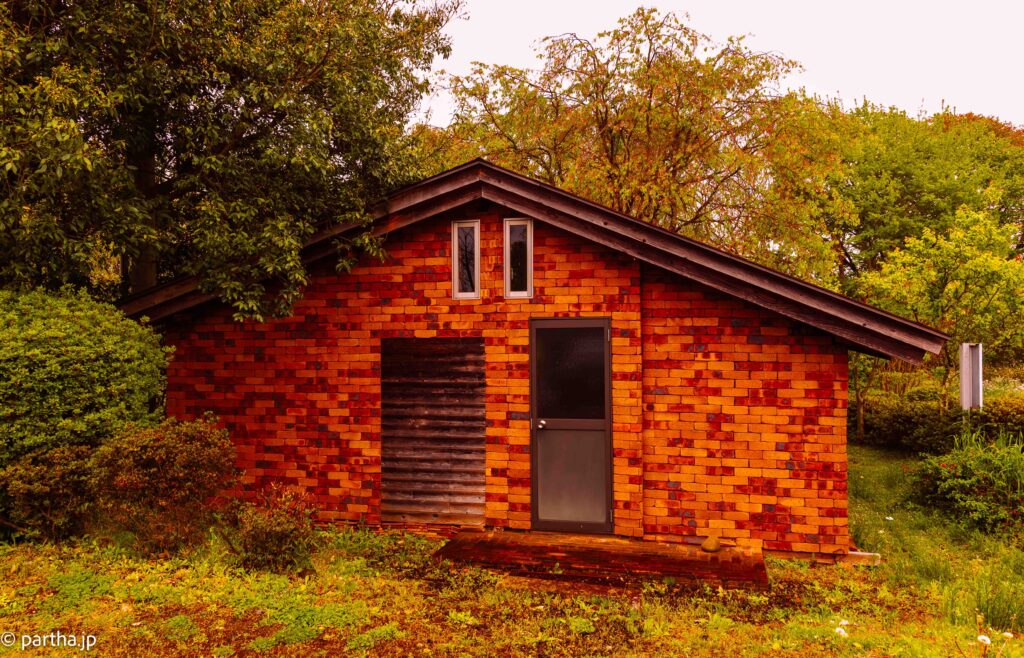
The display has pictures of Holland during the German occupation, details about Anne Frank and her family and a display of a section of her diary. a few Nazi propaganda posters are also shown in the small display area. I visited Amsterdam a few years ago and walked around the Anne Frank Museum but did not have the time to book a tour.
The display is informative for someone who doesn’t know the story but lacks in substance for someone who is familiar with Anne Frank’s diary and the surrounding circumstances.
The last part of the tour was an art display or paintings and sketches by children from Poland. The display was housed in train carriages which I wrongly assumed were ones that were used for transporting Jewish prisoners to Auschwitz. The exhibit was closed that day and I realised that the train carriages were borrowed from a local railway company, Koriyama(nearby town) was written on the railway carriages.
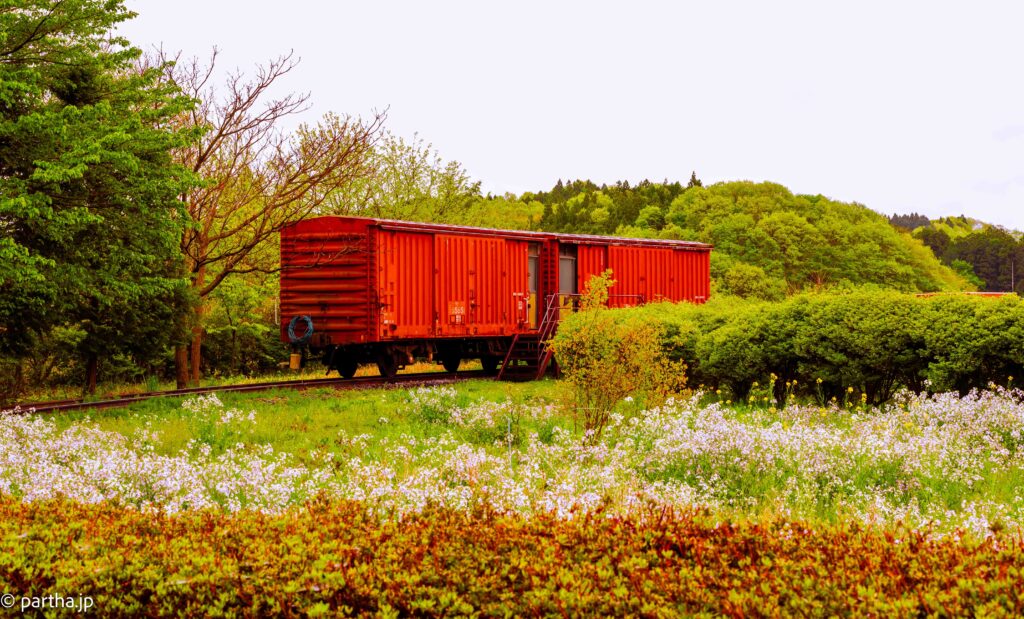
We were the only visitors by the time our tour came to an end, the Harley Davidson from Shinagawa had already left and the parking was empty.
There is a two storied apartment complex next to the museum and I suspect it houses the employees of the nearby brewery. A few houses stand on both sides of the narrow path leading to the museum.
The idea behind the museum is right, more people need to know about the horrors of Auschwitz, but this remote location in a small town in Fukushima prefecture might not be the appropriate place.
The parking space can accommodate around ten cars but the narrow approach road would limit the traffic that flows into the museum.
Auschwitz is still on my mind, two months after my visit, so this small museum that attempts to tell the story in this part of the world is definitely something that needs to be appreciated, however it will take more investment and publicity to broadcast the details of this horror to a wider audience.
The rain started to pick-up as we left Shirakawa and drove towards our destination, an Air BnB located close to the Zao ski resort in the mountain region of southern Miyagi prefecture.
We exited the Tohoku Expressway at the Shiorishi Interchange and reached the National Road 457 before entering into a narrow winding road. The rain was a downpour now, a small storm in the making which was a mixed blessing as the road was almost empty and devoid of traffic.
I steered the car through sharp turns, the road barely wide enough for a passing vehicle at places. However the Air BnB address was registered on the car navigation system and we reached our place without a wrong turn.
Initial plans had been to do some hiking the following day but the heavy rain on the previous evening made me skip hiking and plan a visit to the Tsunami hit regions of the Miyagi prefecture.
I have mixed feelings about disaster tourism, visiting a location because it was affected by natural calamities might be insensitive but visiting such a location is also supporting the recovery and sometimes by paying the entrance fee to a facility contributing to it.
The 2011 earthquake, also known as the Great East Japan Earthquake or the Great Tohoku Earthquake, Shinsai Jishin(震災地震)in Japanese, was one of the strongest earthquakes ever recorded in modern times. The Tsunami that followed and the resulting nuclear meltdown at Fukushima affected people all over Northern Japan, including me and my family in Tokyo.
I wrote about the earthquake in my blog https://partha.jp/index.htm/shakeout/ , the next few months made me question my decision to stay back in Japan, the government revealed after a few years that they were close to ordering an evacuation of Tokyo. The daily reports of increasing radiation levels in the water supply, the shortage of mineral water in stores and the continuing aftershocks is something that we still remember.
“All at once … something we could only have imagined was upon us – and we could still only imagine it,” the journalist Philip Gourevitch once wrote. “That is what fascinates me most in existence: the peculiar necessity of imagining what is, in fact, real.”
Life returned to normal for us, living in Tokyo, around 350 kilometres away from the centre of the earthquake, but the Tsunami affected regions took a long time, sometimes a decade to return to normalcy. The area around the Fukushima Nuclear plant were permanently abandoned and cannot be accessed due to the high radiation levels in the soil.
Around 20,000 lives were lost during the earthquake and the Tsunami, Miyagi prefecture accounted for 10,800 of those deaths. Ishinomaki city suffered the greatest of the losses , the Tsunami waves were at times 40 metres high and destroyed everything in their path.
The city has rebuilt over the years and has created monuments showcasing the recovery from the disaster. These are pilgrimage sites, places you can visit and remember the ones who died, read about the heroism of others who helped others and marvel at the resilience of human beings.
There are online guides helping one plan a trip and as I used Google Maps to plot out a route the first one that came up was the Nobiru Railway station near Higashi Matsuyama city. Around 1,100 lives were lost due to the Tsunami in this city.
The Nobiru station platform has been preserved, it retains the scars of the Tsunami, a rusting and damaged structure with twisted pillars, a testament to the fury nature can unleash. The station structure was abandoned and has been rebuilt as a museum, it does not function as a railway station any longer.

The staff at the station were keen and helpful, handing out pamphlets and switching on a video about the Tsunami and the accompanying disaster. There is a damaged ticket vending machine on display and on the second floor the escape path of the station staff. As Tsunami warnings were broadcast, the staff used the emergency ladders to climb to the roof of the station and survived the Tsunami.
There is a memorial plaza next to the station building with a monument that has wavy patterns 3.7 metres in height, the same height as the Tsunami that hit the area. The names of those whose bodies were never recovered are inscribed on a plaque. There is another stone inscription bearing a poem written by Princess Michiko, the former empress of Japan.

The memorial park has a few displays explaining the history of the town, it was a mining town for stones that were used in construction of houses till the mid 1950s. The stones apparently did not age well and their use was discontinued and mining died out in the region.
Our plan was to head into Ishinomaki city for a few more Tsunami monuments, however the signboards around station area pointed to a few more tourist spots. One of the activities was a pleasure boat ride around the coast with a view of some of the rock formations and Sagaeki Gorge.
The drive from the station to the boating docks goes along the coast, there is an area around the beach where one can park the car and take a walk. The wind was strong and the waves high as we took a walk around the beach. It was a bright sunny day and the sparse crowds, the cool winds made for a perfect day.
We reached the parking area near the docks but struggled to find the ticket booth for the boat rides. A couple of ladies running a small toy stall helpfully guided us to the store that also served as a booth for boat ride tickets, introducing us to the boat captain.
‘The waves are strong today’, the boat captain said ’the tour will be around the coast and not venture out into the sea’.
We were agreeable and bought the tickets and were shown the seats where we could wait till the captain called us for the tour. There were a few food stalls and a food truck but the crowds were light. There was another family on the boat ride, an aged couple and their middle aged son.
’Nice Camera’, the lady working with the boat captain remarked, my long range lens adding to the camera’s appeal.
‘I too have a Nikon D750’, she remarked after catching a view of the make ’ please take a lot of pictures and publicise our tour’.
I promised to do that just that, telling her I would upload them on my Instagram page.
The boat did not have seats and we had to sit cross legged on the floor, straining our necks to catch the view from the window. I needed to take pictures so rested on my knees for a stretch to capture the view outside.
The 45 minute tour took us along the coast, the unique rock formations, the oyster fishing structures, the captain describing the effects of the Tsunami on the area.
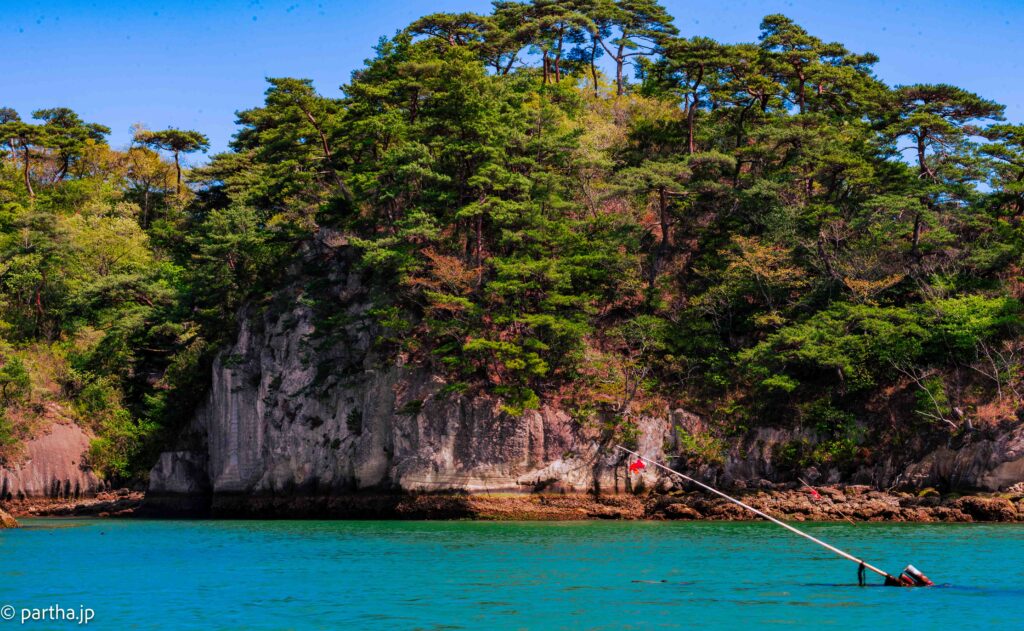
He pointed out places where houses stood before they were wiped out, the old boating docks that had to be abandoned because there was no quick escape route to a higher ground, the new bridges that came up over the last few years replacing the older damaged structures.
The effects of the earthquake and Tsunami are everywhere and the majority of the boat tour was about how the region was before the Tsunami and what changed afterwards.
I could imagine the devastation, the loss of lives and livelihoods, this area was right next to the sea and would have taken a direct hit. The road snaked around the coast, so escape would not have been easy and there wasn’t much of accessible higher ground around here.

Fourteen years have passed since the Tsunami and except the structures that have been deliberately preserved much has been rebuilt around the region. Tourists have returned, the tsunami monuments being the added attraction.
We visited the place in the middle of the Golden Week holiday season, however this was apparently off season, the tourists came in Summer when the weather was more stable and the waves milder.
It was around 14:00 when we finished the boat ride and we looked for a place to have lunch before heading to the Tsunami memorial park in Ishinomaki.
A Nepali/Indian restaurant was located close to the park and was largely empty in the late afternoon hour. Two ladies greeted us warmly, took our orders and bought a massive Naan along with a really delicious curry. Indian restaurants in the remote towns are sometimes tricky, the lack of competition results in lesser efforts and food of questionable taste, but this was one of the better ones I encountered in my travels. To those who are interested the link to the restaurant is https://www.instagram.com/sathi_resturant_/
The Tsunami Disaster Memorial Museum was a 7 minute drive from the restaurant and has a massive car parking. The circular museum building was at an elevation from the parking and clearly visible along with a viewing point above the hilltop.
The pamphlet from the museum describes it as ‘The museum is a circular building with an indoor diameter of 40 metres with a scattering of slender columns constructed and arranged to support the roof. It is designed so that when pine trees planted around the building grow, a continuous inside outside space will be realised’.

There are clumps of Pine Trees planted around the building, there was a small Pine Forest here before the Tsunami devastated the area and planting these trees is an attempt to recreate the forest. There is a small reflecting pool and a pond below that overlooks the Sendai Bay.
The park is wide and there were a few families with their children and pets enjoying their holiday. A pulp factory spewed smoke at a distance and dusk would have made a wonderful picture view.
We entered the museum, the staff was eager ad polite, pointing out the exhibits, the video room, the VR headsets with a 360 degree view of the area before the Tsunami.
Touch Screen Displays explained how the area looked before and after the Tsunami, the death and destruction that accompanied and the reason why the museum stands, to make sure people learn from the disasters and are prepared for the next one.
Tsunami was almost a myth till the 2004 disaster that hit Aceh and other countries in the region. Then came 2011 and all of us in Japan realised it’s destructive power streamed on television screens in real time.
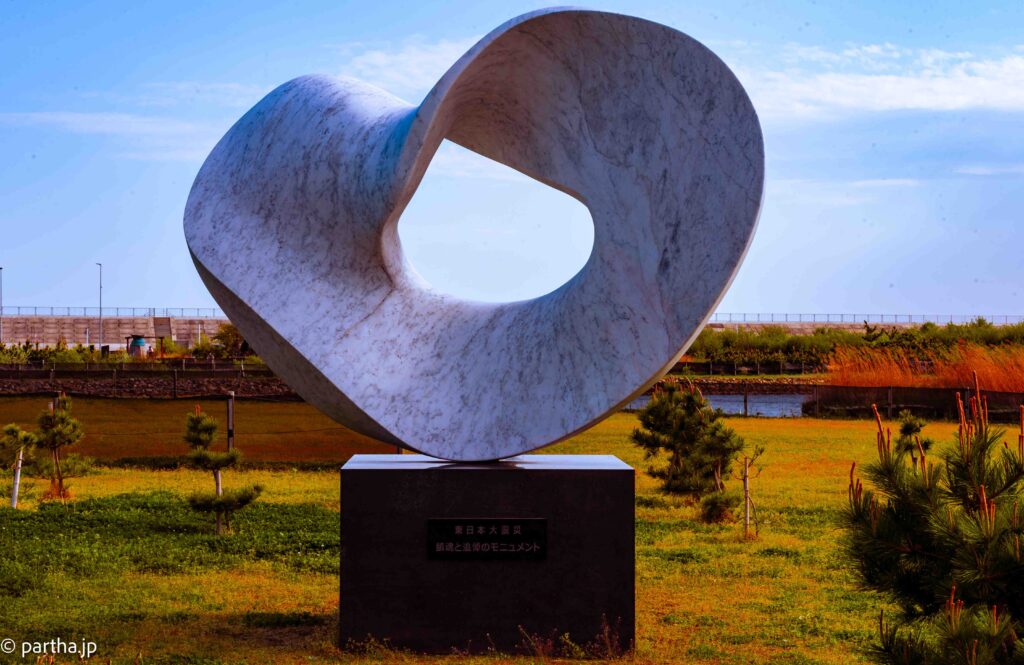
I remember that day, walking home after the earthquake, all public transportation in Tokyo stopped and seeing Tsunami waves hit the region on television monitors in shops on my way. The aim of the museum is to raise awareness of natural disasters and make sure we are not complacent when the next one hits.
We climbed to the viewing spot atop the hill, Sendai Bay visible along with all the reconstruction that has happened in the region over the last decade and half.
There was one building that still stood as it was, clearly visible from the museum, the Ichinomaki City Kadonowaki Elementary School Building. Amongst all the reconstructed buildings this one stood out, the ruins of a burnt out structure.

We made our way down the hill, walked across the car park, crossed the road and entered the area housing the burnt out structure. The building stands as it was on the day it was destroyed, there is a newer structure next to it, the Exhibition Room entrance.
The exhibition area closed at 17:00 and the last entry to the building is at 16:00, we were a few minutes past yet the staff had no problems in allowing us in. There is a 600 Yen Fee to enter the building and a middle aged British Man came over to talk to us.
He was a volunteer working at the disaster memorial guiding disaster tourists in English. There were a smattering of tourists, mostly Japanese speaking, but we overheard a few English conversations in American accents.
The school was evacuated immediately after the Tsunami, there were more than 200 students in the school at the time the earthquake stuck and they were all escorted to the nearby Hiyoriyama Park.
However some of the teachers and a few local residents stayed back in the school to direct any parents looking for their children. When the Tsunami stuck they all move to higher floors. However the Tsunami bought burning debris along with it that made the school building catch fire.
The remaining staff and other people used the podiums at the school to create a structure allowing them to escape to the nearby hill! Everyone in the school, the students, the staff and the nearby residents survived.
The quick thinking of the teachers and the people at the school was amazing, they were hit repeatedly by waves of the tsunami, the structure they were standing in was burning down and yet they were able to think of putting together a ramshackle bridge and escape to the nearby hill top.
The 2011 earthquake was one of the greatest disasters to hit Japan, 20,000 lives lost in a few hours, yet this story of remarkable survival , the heroism and quick thinking of the school staff was a fitting end to the trip.
Earthquakes are common in Japan and sometimes complacency builds up when we go through them on a regular basis. However the evacuation drills, the seriousness with which they are taken are what save lives, as this school showed us.
The blackened outer structure, the burnt out classrooms, desks, chairs, a blackboard collapsed in the room misshapen by fire or water, a skeleton of a building and yet a remarkable story behind it.
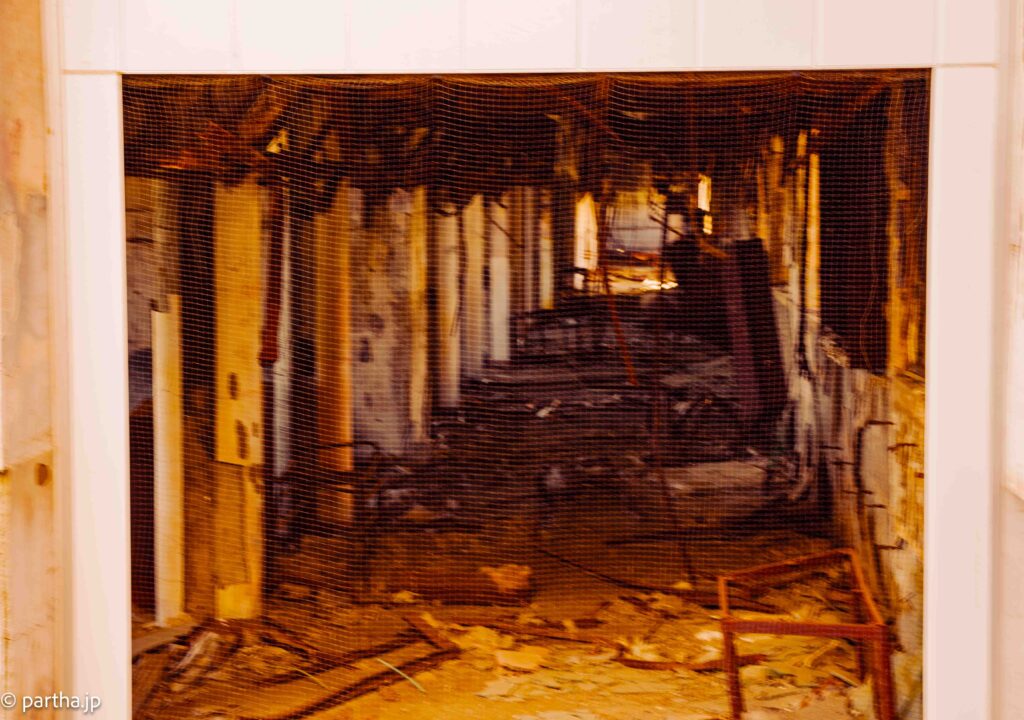
Tohoku was a relatively unknown to tourists before the 2011 earthquake and the awareness of the region increased after the disaster. The rebuilding efforts attracted volunteers and brought attention from overseas tourists.
The current explosion of inbound tourists in Japan seems to have passed this region by. The proximity to Fukushima nuclear plant might have kept away tourists from the neighbouring countries, public transport is still not widely available so organized group tours are the only means of getting around.
We drove out of the parking area, dusk was falling and as we entered the winding roads of the Zao area, rain started again. There was traffic though relatively sparse and the odd sharp curve required stopping to ensure the oncoming vehicle could pass.
I had debated about going to Ishinomaki, there is a a certain ghoulishness associated with visiting sites of disasters, walking on beaches where relatives still scour for remains of their loves ones, treading over ground where death and destruction once prevailed.
However the disaster memorials do not dwell over death, they celebrate survival. The Nobiru railway station or the Kadonowaki elementary school building are monuments not to death but the human instinct for survival.
Natural disasters are part of life in Japan, the ever present threat of an earthquake, the Kanto region that encompasses Tokyo and surrounding prefectures has been preparing for a big earthquake for more than decade, the government has evacuation measures in place if Mt Fuji, the sacred and symbolic mountain that is still an active volcano, erupts.
Climate change brings in hotter summers, unpredictable rainfall and extreme weather in winters. The violence of the surrounding nature, the memories of a violent past , less than a century old, has built in resilience and a desire for order.
Richard Lloyd Parry, is The Times correspondent in Japan lived through the 2011 earthquake and spent more than six months covering the disaster. He wrote a book ‘Ghosts of the Tsunami’ a heartbreaking account of the Tsunami and its aftermath. The book covers the death of children at the Okawa elementary school, the political failures and accounts that gives the books its title, the tales of ghosts of people who died in the 2011 earthquake and tsunami turning up at different places in the region.
He quotes a Shinto priest, beautifully describing the acceptance of living in a region where natural disasters are a part of the daily life
It is the universe we inhabit, and the only life we have on these islands, volcanoes ,earthquake, tsunami and typhoon… they are as much a part of Japan as the rich crops in the fields.
A Shinto Priest -Ghosts of the Tsunami
The Metal Mass
I returned to Tokyo and went on a few work trips overseas, writing about the Ishinomaki trip took a while. There were bits remembered, there were others where I had to refer to the pamphlets I collected to jog my memory but there was something I forgot.
As the processed the 500 odd pictures I took during the trip, one of the pictures brought back a memory I lost in the haze of passed time.
As we drove out of the Nobiru station memorial, driving along the Nobiru coast , I could see people parking their cars along the paved path and getting out to take pictures along the coast. A few tourist buses were parked at a distance, the crowds getting down and walking along the beach.
I stopped my car on the pavement, parking along a beach is a luxury not available in Tokyo, and climbed down the concrete sea wall to walk along the beach. There was coarse sand in my part of the beach, rocks strewn at places, vegetation at spots.
The sea was rough, waves crashed into the shore and I walked closer to get more pictures when a strange apparition caught my eye. There was something a few metres away, I thought it was a rock and as I walked closed realised it wasn’t.
This was a twisted, mangled and rusting mass of metal, deformed beyond recognition. There were marking on this mass illegible after years, possibly a decade of exposure to rain, snow, winds, dust and the Sun.
It lay in the middle of the beach, there were no signs warning people to not go near or touch it, it wasn’t cordoned off to prevent injuries from the sharp metal and nothing to indicate its origins.
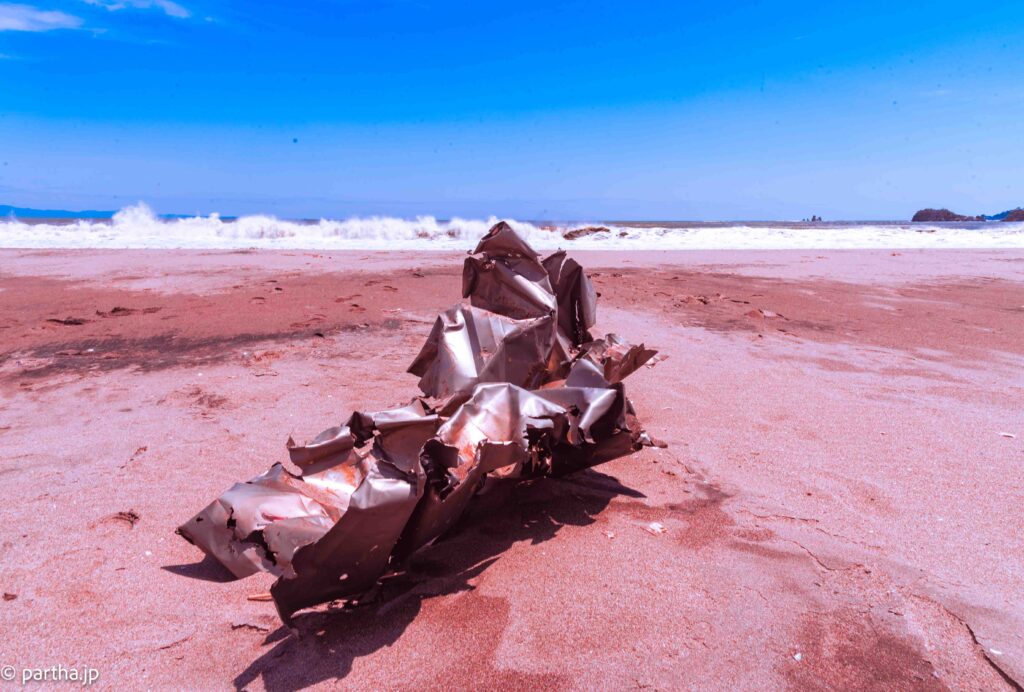
It was, I was rationalising here, Tsunami debris, something that got washed into the sea and then washed back in. It must have washed back after the initial cleanup operations were over so it was left there waiting either for the next cleanup or left to nature.
It could have been the hull of a boat, the body of an automobile, there were marking on the twisted mass that must have meant something to someone at some point of time.
There was no memorial around it, the mystery of its origins unknown to us outsiders, the disaster tourists. This abandoned mass of twisted metal, the byproduct of a violent event was left out there for all to see, at least those who came to this unpeopled part of the beach.
Tohoku has moved past the earthquake and the Tsunami, they built memorials to the dead, monuments to the spirit that kept others living and rebuilt all that was destroyed. All that has been rebuilt has been done keeping in mind the fact that there might be another Tsunami in the future and people would need to evacuate to higher ground.
The debris that accumulated in the immediate aftermath was cleared, but others continued to wash back over the years. This metal mass might be cleared one day or just left out there. There are remains of the dead on these beaches, bones that are stuck beneath the sand, the relatives of the dead still search for the remains.
The twisted metal mass stands out from far, it is a reminder that something dreadful happened on these shores, the violence of that day embedded in the twisted folds of metal corroding away slowly.
It will be gone in a few decades as will be the ones who remember the disaster , the day March 11 etched in history along with many others from the past and the ones that will come in the future.
We walked back to the car on the lonely beach, no one around in a few hundred metres. Tourists were still few and far on this late spring day. The only sounds were of the waves, still crashing on to the shores!
